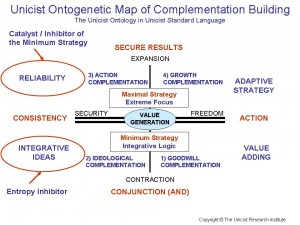The following excerpt is a repost of the Unicist Blog.
The 10-year Global Future Scenario of Objects driven Virtual Collaboration, developed by the Future Research Lab of The Unicist Research Institute and led by Peter Belohlavek, defines the trend towards this type of work organization when some of the following conditions are given:
- Extreme specialized solutions are needed
- There is a need for time saving
- There is a need for timing
- Transparency of work processes
- Reliability systems
- Customer orientation
- Quality assurance in work process
About Virtual Collaboration
The communication and IT technologies allowed making the next step in organizational design, integrating personal and virtual collaboration, organizing roles and using business objects, to maximize results and minimize costs.
This is a change in working habits that is extremely valuable to manage the adaptive aspects of businesses.
The virtual collaboration allows developing both internal and external work processes. The introduction of this technology needs to begin with the activity where the productivity increase is needed the most.
Marshall McLuhan said: “The Medium is the Message”. There is no doubt that virtual media are less powerful than in-person activities to build personal relationships. Therefore it is necessary to compensate this characteristic with an increase of functionality in the group dynamics.
Functionality is increased by using business objects (that introduce functional adaptive automation into the processes). The use of business objects driven work processes allows increasing the functionality of virtual collaboration processes and building a context of simplicity.
In order to achieve group synergy, it is required that the group follows a protocol that establishes the rules of actions and the distribution of credits for its members.
It has to be considered that the bond established between the members of a group is basic to provide a collaboration context that allows achieving synergy and thus increases the productivity.
The fundamentals of this bond are given by the complementation between the members, the functionality of each role and the personal link between the members.
The drivers of this trend are:
- The use of virtual collaboration at a personal level on Internet
- The massification of the use of Internet
- The use of virtual collaboration by many leading organization such a: Shell, IBM, Deloitte, Google, Cisco, etc.
The new technologies that sustain this trend:
- Cloud computing
- Audio/Video-conferencing
- Data-sharing
- Desktop-sharing
- Web-conferencing
- Imaging technologies
- Object Driven Organization
- Adaptive IT Solutions
- Client Centered Management
Where will Virtual Collaboration be installed as a standard within the next 10 years?
- Project Management
- Work Process Monitoring
- Home Office
- Research & Development
- Counseling/Coaching/Tutoring
- Business consulting
- Auditing
- IT R&D
- Virtual Negotiations
- B2B Marketing
- Buying Processes
- Business Monitoring
- Customer Support
- Auditing
- Corporate Universities
- Medical Consultations
- Medical Prevention
- Medical Monitoring
- Clinical Trials
To access the basics on Unicist Future Research
please enter: www.unicist.org/sdp.shtml
Subjectivism is the killer of Virtual Collaboration
Subjectivism at work is the prevalence of subjective, ungrounded opinions, which prevail over any foundations that can be installed by a counterpart. Subjectivism implies the need of using distortive perceptions, denial and fallacies to avoid dealing with the actual problems.
Subjectivism is necessarily driven by manipulation which necessarily requires an extreme use of emotional influence to avoid dealing with the functional aspects of reality.
http://unicist.net/economics/manipulation-is-a-long-term-business-killer/
Therefore virtual collaboration requires working in functional environments where the roles of individuals are recognized by the results they can produce and their capacity of teamwork. Subjectivists can use virtual communication but not virtual collaboration.
Access the complete synthesis at:
http://unicist.net/management/the-10-year-global-future-scenario-of-objects-driven-virtual-collaboration/


